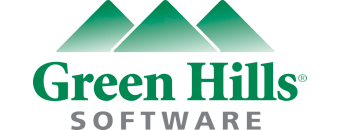News & Press
Green Hills Software Releases MULTI 4.0 Improving Productivity Across All Phases of Development
New Version Offers Enhanced IDE and Low-level Bare-board Debugging Features
BOSTON - September 15, 2003 - Green Hills Software, Inc., the technology leader in real-time operating systems and embedded software development tools, today announced the release of MULTI 4.0, its flagship integrated development environment (IDE) for embedded developers.
Key features of the new version include powerful data visualization, workspace management, and low-level, bare-board debugging features that allow developers to efficiently perform the gamut of software development activities, ranging from connecting to, exercising, and testing new boards through advanced application debugging and project management.
"MULTI 4.0's enhanced board bring up tools make Green Hills the only company to bring advanced high-level and low-level development tools into a single IDE," said David Kleidermacher, vice president of engineering at Green Hills Software.
The MULTI IDE has been extended to improve developer productivity over more aspects of the software development process. The Workspace Manager provides a graphical interface for managing sequences of commonly used actions within the IDE. For example, a user may often start a session by first updating the project from the configuration management system, then building the project, followed by connecting the debugger to the remote embedded system, and finally downloading the application. This sequence of operations can be created and added graphically into a Workspace, where it can then be executed on demand with a single click. By managing complex operations efficiently, developers can focus on and solve their application-specific problems more quickly.
Another set of important IDE enhancements improves how developers visualize the data structures in their applications. One example applies to C++ programmers using the Standard Template Library (STL). STL container implementations typically obfuscate the application data, forcing programmers to waste valuable time traversing unfamiliar, complex data structures. MULTI eliminates this inefficiency by hiding the implementation details and displaying only the relevant content.
The MULTI Editor supports complete cross reference browsing capabilities without the need for a compiled or linked program, and the Editor intelligently discovers function prototypes included in header files so the user can see the required function signatures while typing, without requiring any previous configuration.
MULTI 4.0 offers significantly enhanced support for low-level debugging, including:
- Low-intrusion mode allows the restriction of accesses to memory and registers when debugging sensitive code segments such as board initialization.
- Enhanced register visualization provides an improved data book display of core registers and allows on-the-fly creation of descriptions for additional peripheral registers.
- The memory test wizard manages a comprehensive battery of tests to quickly and thoroughly exercise and verify memory.
- Script debugging records and allows controlled replay of the sequence of actions made while adjusting system variables and registers during board initialization.
- PCI visualization allows developers to quickly enumerate attached devices (including devices across bridges) and to view and control them.
Other MULTI 4.0 features assisting in low-level debugging include a generic serial terminal that provides an integrated and consistent view across host platforms, a hex editor for editing binary files, and an improved graphical flash programmer extensible to custom flash devices.
MULTI 4.0 also provides seamless integration with the recently announced TimeMachine debugger and SuperTrace probe. The combination of these products revolutionize the way developers approach debugging, providing unprecedented visibility into code execution and enabling discovery and eradication of the most difficult, intermittent bugs and glitches.
Availability
MULTI 4.0 will support PowerPC, ARM, MIPS, x86/Pentium, 68K/Coldfire, V800, and StarCore processor families as well as native development for Windows, Solaris, and Linux. MULTI 4.0 is scheduled to ship in Q4 2003.
About Green Hills Software
Founded in 1982, Green Hills Software, Inc. is the technology leader for real-time operating systems and software development tools for 32- and 64-bit embedded systems. The royalty-free INTEGRITY RTOS, compilers, MULTI and AdaMULTI Integrated Development Environments and Green Hills Probe product line offer a complete development solution that addresses embedded systems from the lowest cost consumer products to the most safety-critical aircraft flight systems. Green Hills Software is headquartered in Santa Barbara, CA with European headquarters in the United Kingdom.
Green Hills Software, the Green Hills logo, MULTI and INTEGRITY are registered trademarks. SuperTrace Probe and AdaMULTI are trademarks of Green Hills Software, Inc. All other trademarks (registered or otherwise) are the property of their respective companies. Brand or product names are registered trademarks or trademarks of their respective holders.
North American Sales Contact: Green Hills Software, Inc., 30 West Sola Street, Santa Barbara, CA 93101, Tel: 805-965-6044, Fax: 805-965-6343, Website: www.ghs.com, Email: sales@ghs.com.
International Sales Contact: Green Hills Software Ltd., Dolphin House, St. Peter Street, Winchester Hampshire SO23 8BW, United Kingdom, Tel: +44 (0)1962 829820, Fax: +44 (0)1962 890300, Email: mktg-europe@ghs.com.
Media Contacts:
Green Hills Software, Inc.
Lynn J. Robinson
(805) 965-6044
lynnr@ghs.com
Patterson & Associates
Barbara Stewart
(480) 488-6909
barbara@patterson.com


